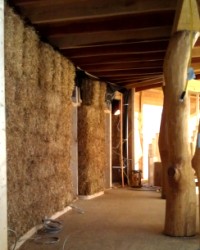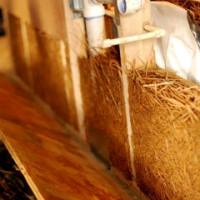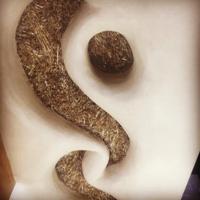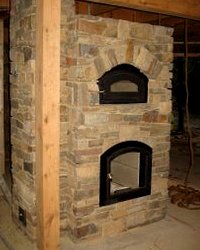Straw is agricultural waste from any grain farming and is ubiquitous everywhere in
the world where agriculture exists. Strawbale construction is a method for building
super insulated walls using stacked fuzzy bricks made of straw.
Strawbales create a monolithic, solid wall system that is plastered on both sides,
usually with clay or lime based breathable plasters. Straw is best used where you
benefit from high insulation (R-value tests between R-36 and R-48 for 18" bales).
For example if you heat a space in winter, you want insulating walls to keep the
heat inside, saving on energy costs.
There are a few incorrect myths about strawbales, so let's set the record straight:
1. YES, you can build with straw in wet/humid climates
2. NO, your house won't be flammable
3. NO, your walls will not be filled with insects or rodents
4. YES, you can get a standard building permit
5. YES, you can get insurance & financing
(and NO, the big bad wolf will not blow your house down)
Loadbearing strawbale means the straw wall supports the weights of the roof and any floors, without posts. The bales are stacked like bricks and pinned together for stability. A structural box beam runs across the top of the strawbale walls to distribute any roof or floor loads evenly onto the strawbales. The bale wall is compressed by cynching the box beam tightly to the foundation.
To ensure stability, structural strawbale walls should have a ratio of height to width that does not exceed 5.6 to 1 (ie, the height should not be more than 5.6 times the width of your bales) and the ratio of unsupported length to bale width should not exceed 13 to 1 (ie, an un-buttressed wall should not be more than 13 times the width of your bales).
Loadbearing strawbale walls may require a structural engineering stamp in order to receive a building permit.
Infill strawbale describes a non-structural method for using bales to super-insulate walls, with tested R-values between 2 and 2.7 per inch thickness. The strawbales are fitted around an existing structural frame, such as a post-and-beam structure, timberframing, or stud walls. All of the building loads are supported by the frame, not the strawbales. Infill strawbale can also be used to insulate existing walls.
Infill strawbale meets all building codes in the U.S., so acquiring a building permit is quite straightforward. The infill method is a great choice where weather is unpredictable, since the roof is completed prior to strawbale installation (thus providing protection from rain as walls are built).
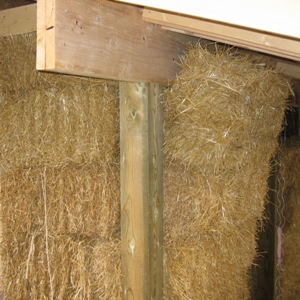
Straw Wall Systems
Super-insulating walls made with strawbales stacked like bricks
more info
Loadbearing Strawbale
Infill Strawbale
a great choice where super insulating walls are desired, in regions with frequent rainfall, and for projects that require a building permit
a great choice where super insulating walls are desired and wood is a scarce local resource
infill strawbale, notched around posts & beams
curvy strawbales & tree columns
Clay minerals have very small, platelet-shaped particles, that create sticky little suction cups when wet and keep a strong internal bond when dry. That stickiness and plasticity is what makes clay such a great binding "glue" for a variety of natural building materials. Because clay expands when wet (making it sticky) and then shrinks as the water evaporates, clay-based building materials include an aggregate, such as sand, to increase strength and reduce shrinking (and thus reduce cracking). There are many different types of clay, with different capacity to absorb water, different expansion, different stickiness.
Clay building materials are classified as "thermal mass", which means they act as a battery or fly-wheel for heat energy...absorbing heat energy when the environment around is warmer and releasing heat energy when the environment around is cooler. Clay walls work well as solar heat storage (trombe walls) in passive solar designs. Clay materials do not have insulating value, so should be used where high thermal mass, not insulators, provide the best energy performance.
Rammed earth uses a mixture of clay and sand tamped into formwork to create a monolithic wall system. The compression of the tamping mimics natural geologic forces that form sedimentary rock, so rammed earth construction resembles hand-formed sedimentary stone. Rammed earth is denser than adobe or cob, making it stronger and providing higher thermal mass per volume. Tamping is traditionally done by hand, though modern rammed earth often uses pneumatic machines. It takes surprisingly little effort to hand tamp!
Rammed earth provides excellent heat storage for solar walls or natural cooling.
Cob is sometimes called "sculptural adobe", because it uses the same ingredients as adobe bricks (clay, sand and straw or other fiber). The difference is that cob is formed, or sculpted, in place. Cob walls are built while the clay mixture is wet (whereas adobe bricks are sun-baked). Wet clay has a limited capacity to support weight before it begins to flow like a liquid, so walls need to dry in place as you build in order to be strong enough to support additional weight above.
Cob walls are often built in a battered form, which means they slope inward as you go up, getting thinner and thinner towards the top. The wall essentially leans in on itself for stability.
Adobe refers to bricks formed with a wet mixture of clay, sand and long straw or other fibers. Cow dung can also be added to give the adobe more water-resistance. The mixture is poured into molds, the top is smoothed, the forms are removed, and the bricks are placed in the sun to dry. Sun-baking hardens the clay to create strong building blocks.
When dry, the adobe bricks can be stacked like any other block masonry, using mortar made from a wet clay mixture similar to the original adobe recipe.

Clay Wall Systems
Various wall systems made using clay as the binder
more info
CEB stands for compressed earth block...essentially bricks made from rammed earth (see above). The blocks are typically manufactured onsite using a hydraulic extrusion machine called a Cimva Ram. The blocks can be shaped to interlock with each other so they can be assembled without the use of mortar. CEB walls are very high mass and can be erected very quickly (once bricks are made).
Cob
Rammed Earth
CEB
Adobe
a great choice for energy-absorbing mass walls, such as solar heated walls, especially where faster construction is beneficial
a great choice for energy-absorbing mass walls, especially where highly sculptural walls are desired
great choice for high density, energy-absorbing mass walls
great choice for high density, energy-absorbing mass walls, espeically where faster construction is beneficial
sculpted cob wall swoops up a staircase
cob wall meets a tree column
Are you intrigued by natural building but
confused by what all the terms mean?
This glossary is written for you!
We have been building naturally for most of history.
The materials are age-0ld but the terms we use are
relatively new to the current dialog about
construction.
As a result, I often notice confusion in the use of
different natural building terms, as well as confusion
about how each material can be used to its best
advantage.
This glossary helps dispel some of the
confusion with natural building terms.
Several natural building materials are actually hybrids..combining two or more
natural materials. Some of these are described below, along with suggests for how
best to use each.
The key to understanding hybrid materials is to understand the properties of each
ingredient. Kindof like baking. But invariably with mud. Here's a brief breakdown
of the major natural ingredients:
clay: super sticky; creates internal structure for a variety of applications
sand: aggregate; prevents shrinkage & cracking in clay materials
straw: insulating fiber; provides insulation & knits clay materials together
wood: high compressive strength; ideal for supporting structural loads
lime: sticky binder; ideal for making water-resistent plasters & paints
Wattle & daub is an ancient technique where a sticky clay mixture is pushed into woven lattice work. The lattice, or wattle, is formed by weaving thin wood or split bamboo around vertical stakes. The daub material is made from a binder (usually clay soil), aggregate (such as sand), and a reinforcing fiber (such as straw). Wattle and daub walls can be quite thin, since their strength is reinforced by the internal lattice work. They are suitable for interior walls, or where exterior walls provide enclosure but do not require high thermal mass or insulating properties.
Light clay straw, or slip straw, is a centuries-old material used for insulation between half-timber (fachwerk) structures. (The name light clay straw is a translation from the German term "leichtlehm", which means "light clay".)
Light clay straw is made by coating loose straw fibers with a light coating of clay slip and then packing the coated straw tightly between formwork. The clay dries and binds the straw like hairspray, creating a solid, insulating wall, rated at a maximum of R-1.5 per inch. The walls can be plastered on both sides.
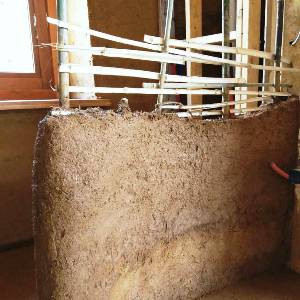
Hybrid Wall Systems
Wall systems comprised of multiple natural materials
more info
Wattle & Daub
Light Clay
Cordwood
Cordwood construction uses short, debarked pieces of wood plus a mortar to build a monolithic masonry wall system. The wood is stacked, like firewood, so that the cut ends become the face of the wall. Each piece of lumber is cut to a uniform length (usually around 16" to 24"), which then determines the thickness of the constructed wall. The mortar used between the wood can be lime-based or clay-based cob. Cordwood walls perform with a combination of insulating and thermal mass properties. The R-value averages R-1 to R-1.25 per inch thickness.
Cordwood can be appropriate for exterior walls and loadbearing walls. This method of construction should only be used where wood is in abundance, especially where log-ends or salvage wood are available for repurposing.
great choice for insulating stud walls or creating acoustic barriers
great choice where thinner, non-loadbearing walls are needed
great choice for insulating walls in regions where wood is ubiquitous
Hempcrete
great choice for non-structural walls that require modest insulation
Hempcrete is a composite made with hemp fiber mixed into a hydraulic lime (NHL)binder. The biocomposite can be formed into blocks or compressed into wall cavities. Once the lime cures, the material is rigid. The tubular fibers trap air pockets in the lime. The air pockets make hempcrete a fairly good insulator. The lime helps to regulate humidity and create a breathable wall system.
Hempcrete can be used to fill non-structural cavities with insulating material that is long-lasting, moisture-regulating, and fire-resistant. Insulation values for hempcrete are tested at R-2 per inch thickness.
Papercrete & Paper Adobe
use for smaller projects, especially in wet areas
Papercrete combines recycled paper pulp fibers with sand and cement. Cement is not a natural material and has a huge greenhouse gas footprint, so the big benefit here is creating a strong stone-like material with very little cement. However, because of the CO2 footprint, I personally believe that use of papercrete should be limited to small projects...such as sinks or countertops. The recipe is 60% paper pulp, 30% sand, and 10% cement. Once mixed together, it can be formed or worked into molds to create a variety of shapes.
Paper Adobe is similar to papercrete, but uses common clay soil, instead of cement, as the binder...so ingredients are recycled paper pulp plus clay soil.
woven bamboo with clay-straw infill (wattle & daub)
light-clay forms coming off
cordwood creativity
Natural paints and plasters use a variety of non-toxic ingredients to make beautiful, durable, and incredibly forgiving finishes that invite experimentation and creativity.
All paints and plasters use a binder, or glue, to make it sticky. The binder is what keeps the paint/plaster glued to where you apply it, and is usually what gives each natural finish its name.
Plasters are distinguished from paint in that they are applied in thicker layers...usually 1/8" thick or more. Because plasters have mass, they also generally include an aggregate material to improve strength and reduce shrinkage as the plaster dries. Sometimes plasters also include fiber reinforcing, such as chopped straw or animal dung.
Natural finishes can be sealed with breathable clear sealers, such as hardening oils or beeswax paste.
Lime plaster can be confusing, because the term 'lime' can refer to various chemically different (but related) materials. (Not to mention the citrus fruit!)
Lime plaster is made using calcium hydroxide and sand. It cures by absorbing CO2 from the air to form calcium carbonate (limestone). So basically, you are plastering limestone onto your walls.
Lime plasters are suitable finishes over nearly every natural substrate, and creates a breathable (vapor permeable) surface that is weather-proof. I use it for exterior plasters on strawbale as well as in shower enclosures.
Clay-based plasters use sticky clay binders to adhere to walls. Clay is sourced from the earth, often found locally in the soils nearby the building site, meaning the materials are literally dirt cheap and non-toxic. Since clay increases in volume when wet, and then shrinks when dry, sand is added to control cracking (since sand is the same volume wet or dry) and to strengthen the plaster. Clay creates a breathable finish with the natural capacity to regulate moisture and temperature in the surrounding air. Clay plasters are simple to make and extremely forgiving to use, even for beginners.
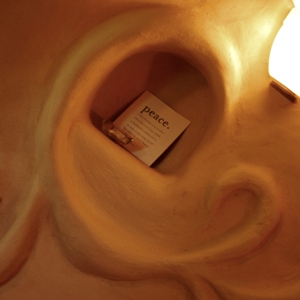
Natural Plasters
wall finishes made with natural, non-toxic materials
more info
Lime Plaster
Clay Plaster
Tadelakt
Tadelakt is a Moroccan technique for polishing lime plaster that creates a smooth, sensuous, waterproof surface.
The traditional application involves polishing lime plaster smooth, first with a steel float to create a smooth tight finis. As the plaster begins to cure, olive oil soap is buffed into the surface with smooth hard stones. Stearic acid in the soap reacts with the calcium in the curing lime to create a waxy binder integral with the surface of the plaster. The wax creates the waterproofing qualities.
Natural Paints
Natural paints describe a variety of paints for a range of applications, all of which are made from natural, non-toxic, non-off-gassing ingredients. Natural paints start with a binder, such as clay, casein (the protein found in milk), egg, beeswax, lime, and others. The binder provides the glue that allows the pigment or color to stick to the surface you are painting. Pigments are generally mineral- or plant-based, so also natural and non-toxic. Not all natural paints are appropriate for every application...for example, clay paints need absorbent surfaces (like unpainted drywall or clay walls), lime paints & washes can be used outside where weather resistance is important, egg yolk paints work on furniture, etc.
use on walls protected from weather and where humidy control is desirable
use on walls where weather resistance or water-proofing are needed
use on walls where waterproofing is needed and a highly polished smooth surface is desired
there are natural paints for nearly every substrate and performance need
sculpted clay plaster and niche
clay plaster around a truth window
lime plaster over strawbales
the zen of polishing tadelakt
the many hues of natural paint
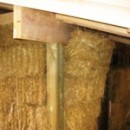
infill & loadbearing strawbale

adobe floor, rubble trench footer, stone
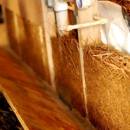
light clay, wattle & daub, cordwood
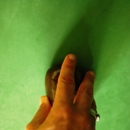
clay & lime plaster, tadelakt, natural paint

timberframing, reciprocal roof
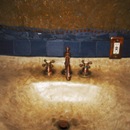
composting toilets, graywater
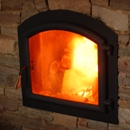
Energy Systems
masonry heater, rocket stove, renewables
Buildings start with a good foundation, and the ultimate durability of a structure is often linked to the quality of the type and installation of that foundation. But foundations aren't that sexy, so they often get overlooked. (Not here!)
I'm also including earthen floors in this section, since they are a great substitute for concrete slab-on-grade installations. (See notes above for characteristics of clay-based materials.)
Adobe floors (also known as earthen floors) are made with the same ingredients as adobe and cob: clay, sand, and straw. The clay is the binder that holds everything together. The sand is the aggregate, that makes the floor strong and helps to control shrinking (and thus cracking) as the floor dries. And the straw provides tensile strength, which knits the material together and also helps to prevent cracking. The surface is sealed when the clay is completely dry, usually with linseed oil or beeswax (or both), to create a beautiful, durable, and wear-resistant floor surface.
Earthen floors work well where a high-thermal mass (heat absorbing) material is beneficial, such as for passive solar designs, and can be used in lieu of any non-structural concrete slab.
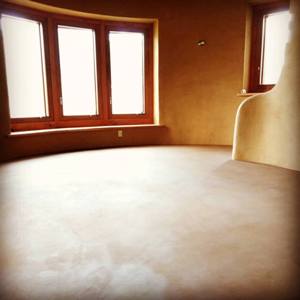
Floors & Foundations
floors & footers that reduce or eliminate concrete
more info
Adobe Floor
Rubble Trench Footers
A rubble trench footer is a continuous trench around the structural perimeter of a building, dug as deeply as the ground freezing point (frost depth) in winter. The trench is lined with filter fabric and filled with stone. A structural grade beam or stone knee wall distributes the structural loads of the building across the surface area of the trench.
This type of foundation uniquely provides both structural bearing as well as water drainage in a single foundation system. Drainage is important with most foundation systems, since water is the single largest culprit for foundation failure. When installed correctly, a rubble trench results in a resource-efficient, high-performing, eco-friendly, and low-cost foundation footer.
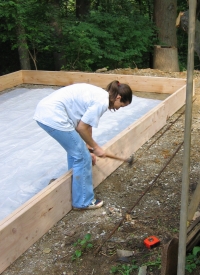
Dry laid stone refers to stone walls that are built without mortar. Eliminating the mortar heightens the importance of fitting each stone to the ones below. Well built dry stone walls are extremely durable and stunningly beautiful. They can be used in place of concrete knee walls and grade beams in rubble trench footers.
Dry Laid Stone
great choice for monolithic slab floors where high thermal mass is beneficial
great choice for any foundation footer, especially where site sensitivity is paramount
use for structural applications where stone is ubiquitous and durability to weather is needed
freshly sealed earthen floor
adobe floors feel good on your feet
securing formwork
The primary purpose of any roofing is protection from the weather. The most
desirable type of roof for any particular application depends on the materials
available locally, the performance characteristics that would best benefit your
building, whether rainwater will be collected from the roof, the pitch of the roof, and
other aesthetic considerations.
Here's how I choose which type of roofing to use for a particular application:
Living Roof where roof slopes are shallow, temperatures are hot in
summer, rain water will not be collected, and the structure can handle extra
weight
Thatch where roof slopes are at least 45o, winters are cold, and the
structure will be exposed on the inside
Slate where roof slopes are moderate to steep, rain water will be
collected, and the structure can handle extra weight, and slate is locally
available
Metal for moderate to steep roof slopes and if rain water will be collected
Thatch is a highly insulating roofing system made by lashing bundles of reeds or straw (or some other appropriate, locally sourced plant) to battens on the roof. Quality thatch is superbly durable, lasting decades, with the ridge sometimes requiring repair or re-thatching each decade or so. There is a perception that thatch roofs are highly flammable (most because of movies, I think), but in fact, the surface can burn, but then it chars and slows the flame (I've read it described as trying to burn a closed book). Thatch is appropriate in any climate, especially where a highly insulating roof helps keep heat inside during Winter and where the roof pitch is at least 45o. Thatch roofs provide between R-2 and R-2.7 per inch thickness.
Living roofs (or green roofs) create an ecosystem that allows plants to thrive on the surface of a rooftop, without access to groundwater...ie, plants survive on rainwater alone.
The two main benefits of planting your roof are absorption of rainwater (especially useful in urban and suburban areas) and a net cooling of the roof surface (to help keep your building cool in summer). Living roofs can work in any climate, especially where a cooling roof will help keep you nice and cool in Summer. Installation of a living roof is easiest when the pitch of the roof is shallower than 30-degrees. The soil & plants do not replace the need for insulation.
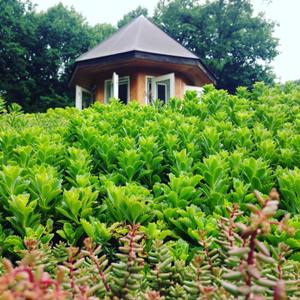
Roofing
Cooling green roofs & super-insulating thatch roofs
more info
Thatch
Living Roof
great choice for cooling roofs, especially where stormwater reduction is useful and roof pitches are shallow
great choice for super-insulating roofs, especially where the structure will be exposed inside and roof pitches are steep
lush succulents on a roof in Maryland
plants keep the space cool below
Likely you use energy.
Maybe even a lot of energy.
Luckily there are technologies to ensure that energy usage keeps environmental impacts to a minimum. Some strategies are free...like passive solar design...which harnesses the sun to minimize or eliminate the need for heating or cooling systems. Some are more costly, like solar panels to generate electricity. But in each case, the solution reduces greenhouse gas emissions and dependence on fossil fuels.
Masonry heaters boost the oxygen intake to boost the burn temperature of a wood fire. The higher temperature burns both solid and gaseous fuel available in the wood, meaning over 90% of available energy is converted to heat. (A normal fire converts only 40% of the wood's fuel into heat.) The excess heat is captured by thick thermal mass (made from stone, clay, or brick)...which then radiates the heat for hours after the fire has burned out.
A masonry heater creates comfort while using a fraction of the wood needed for other wood-burning options. They are also code-compliant where wood is allowed as heating fuel.

Energy Systems
Heating systems that reduce greenhouse gas emissions
more info
Rocket Mass Heater
Masonry Heater
Renewable Energy
Renewable energy technologies harness nature to generate electricity or heat. The most commonly integrated in buildings involve photovoltaic (PV) panels, which convert light from the sun into electricity. Similarly, solar hot water heaters provide free hot water by storing heat from the sun in a tank of water.
Small wind turbines can also convert kinetic energy into electricity. In many places, it's either sunny or windy or both...so a combination of PV panels and wind turbines provides consistent electricity supplies.
the most efficient way to heat with wood
great choice...period
efficient wood heat that is DIY-friendly to build
Rocket mass heaters use a simplified firebox design that is super DIY-friendly. The concept is similar to a masonry heater (see above), but without the comlexity of the inside chamber design. Wood fuel is batch-fed into a burn chamber. Gaseous outflow is channeled into an insulated heat riser, which creates a secondary plasma burn (also called a catalytic burn). The double burn results in more of the wood's total energy being converted into heat (so less wood is used to generate the same thermal comfort). The rocket mass heater encorporates high thermal mass materials which absorb the heat energy and radiate them evenly into the space (for hours after the fire burns out). Code approval can be challenging in some regions.
Passive Solar Design
every building should implement these principles!
Passive solar design takes advantage of the sun's positioning to provide free heat in winter and cooling in summer. The actual design of the building creates the energy efficiencies...with any mechanical systems.
Basic passive solar principles include orientation relative to the sun, using the sun's change in angle to your advantage, and sizing windows depending on which way they face. Passive solar homes also include an airlock at the primary entry to minimize air exchanges between in side and out.
Trombe Wall
high thermal mass wall used to store solar heat energy in passive solar designs
A trombe wall absorbs heat energy from the sun in winter. The wall uses high thermal mass materials, that act as a thermal battery. Placement of the wall allows low winter sun to stream through properly placed windows to warm the mass wall. Heat then radiates from the wall long after the sun has set. In summer, the same wall is shaded, and acts as an air conditioner by absorbing excess heat energy from surrounding air.
a masonry heater efficiently converts wood to heat
free heat from the sun!
masonry heater with a bake oven
solar panels offset energy usage
We treat waste water in about the most backward way possible. That is, we go to the bathroom in drinking water. Then we mix the drains from our toilets with all the sinks & showers, meaning that all of the water exiting a building is contaminated with human waste.
We could instead mimic the way nature handles waste.
How do we do that?
First, separate "blackwater" (from the toilet) from "graywater" (from sinks) and treat each separately. Then, stop pooping into drinking water. Either by using composting toilets or by flushing toilets with graywater (non-drinking water). That's just a no-brainer.
Graywater is defined as waste water from sinks & showers that is not contaminated by toilet flushing. Because graywater starts relatively clean, it can be introduced into the groundwater table with very little treatment.
Most graywater systems include the following components: a flow regulator tank, a sand filter (to remove any potential human pathogens), a mulch bed (to introduce beneficial microbes), and plants (to uptake water and excess nutrients).
Composting toilets use no water. Instead, waste is collected in a compost bin below the toilet where naturally occuring microbes digest the organic matter.
Because the compost is moist but not wet, these toilets do not smell. The trick is understanding the microbes. Decomposition that occurs under water uses anaerobic organisms that thrive in a low-oxygen environment. Those microbes release methane as they do their work...and methane is stinky. The microbes in a composting toilet are aerobic, oxygen loving microbes that do not release methane or any other smelly gas. Instead, composting toilets take human waste and convert it into nutrient rich soil.

Water & Wastewater
composting toilets. graywater recycling
more info
Graywater Systems
Composting Toilets
water-free toilets that turn human waste into fertile compost
excellent companion with composting toilets
wash sink made with clay
homemade composting toilet
graywater uptake garden
The structural system of a building describes everything that goes into supporting all of the loads (weights) and keeping the building from falling over. This includes the weight of the building itself and everything that goes inside it. The structure also counteracts wind forces and, in some cases, earthquakes.
The loads of a building include the weight of the structure itself, plus any snow loads, plus the weight of everything you will put inside the building. Structural framing needs to be sized appropriately to take all of these loads into account.
Wind delivers two types of force on a building. The first is a pushing force, which is counteracted by some sort of lateral (diagonal) bracing to keep the framework from tipping over. The second force is wind uplift, which occurs as wind blows over a roof and creates a negative pressure that pulls the roof upward. Every roof must be fastened down (ultimately down to the foundation) in order to counteract wind uplift.
Timberframe structures are a particular type of post-and-beam construction that does not use nails or other metal fasteners. Instead, timberframing uses interlocking mortise (hole) and tenon (protrusion) joints that fit together like a 3-D puzzle. Each joint is then pinned together with wood pegs. The result is strong rigid joints that resist lateral forces.
This method requires additional time to build, but the result is often worth showing off (instead of hiding inside the wall).
Post-and-beam construction often gets confused with timberframing (see below)...but it actually descrubes a broader category of structures.
It's this simple:
posts are columns that support vertical loads or weights
beams are horizontal supports that span between posts (and may support additional weight along their length)
So post-and-beam structures describe any skeletal structural system that uses vertical supports (posts) with horizontal beams spanning between.
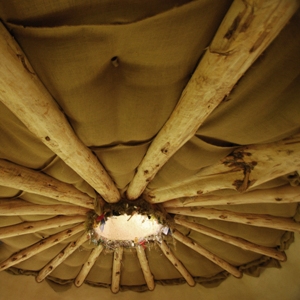
Hat & Boots
components that give your building a good foundation and roof
more info
Timberframing
Post-and-Beam Structures
Reciprocal Roof
Reciprocal rafters support round or conical roof structures without the use of a center post. The framing concept is shockingly simple...each rafter rests on its neighbor around the center. All the joists interlock to counteract lateral loads and keep the roof from thrusting outward (which would cause collapse). Each individual rafter is sizes according to the span and the loads that it supports.
round roof framing option that does not require a center post
good option when the structure will be seen and for projects with additional budgets for fine craftsmanship
good option for any skeletal structural system (where vertical supports can be far apart)
round pole roof framing
site trees peeled & used as columns
timberframe joinery


